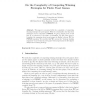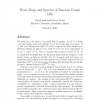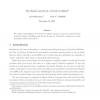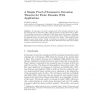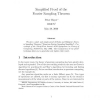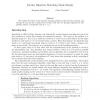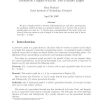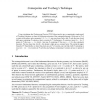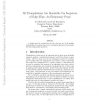132
Voted
MST
2011
14 years 7 months ago
2011
This paper is concerned with the complexity of computing winning strategies for poset games. While it is reasonably clear that such strategies can be computed in PSPACE, we give a ...
128
click to vote
RSA
2010
14 years 11 months ago
2010
We study here the spectra of random lifts of graphs. Let G be a finite connected graph, and let the infinite tree T be its universal cover space. If λ1 and ρ are the spectral ...
106
click to vote
MOR
2007
15 years 13 hour ago
2007
We consider a generalization of the model of stochastic search in an out-forest, introduced and studied by Denardo, Rothblum, and Van der Heyden [1]. We provide a simple proof of ...
103
Voted
JAMDS
2002
15 years 5 days ago
2002
Abstract. In this paper we provide a simple proof of the extension theorem for partial orderings due to Suzumura [1983] when the domain of the partial order is finite. The extensio...
107
Voted
IPL
2000
15 years 9 days ago
2000
We give a short and simple proof of Hales and Hallgren's Fourier Sampling Theorem ["Quantum Fourier Sampling Simplified", Proceedings of the Thirty-First Annual ACM...
119
click to vote
SIGACT
2008
15 years 13 days ago
2008
We examine the classic on-line bipartite matching problem studied by Karp, Vazirani, and Vazirani [8] and provide a simple proof of their result that the Ranking algorithm for thi...
107
click to vote
COMBINATORICA
2008
15 years 18 days ago
2008
We give a simple proof for a theorem of Katchalski, Last, and Valtr, asserting that the maximum number of edges in a geometric graph G on n vertices with no pair of parallel edges...
103
Voted
COMGEO
2010
ACM
15 years 18 days ago
2010
ACM
Using a technique that Tverberg and Vrecica [TV93] discovered to give a surprisingly simple proof of Tverberg's theorem, we show the following extension of the centerpoint th...
90
Voted
CAGD
2008
15 years 18 days ago
2008
A simple proof is provided for the fact that the set of all possible triangulations of a planar point set in a polygonal domain is closed under the basic diagonal flip operation.
109
Voted
ACS
2010
15 years 19 days ago
2010
: Bisets can be considered as categories. This note uses this point of view to give a simple proof of a Mackey-like formula expressing the tensor product of two induced bimodules. ...
